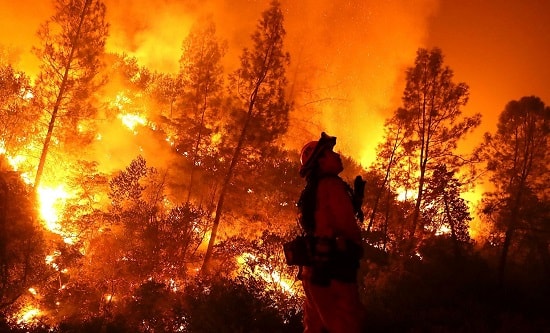
For at least 20 years there has been scientific consensus that human-made climate change is happening and is a serious threat. Yet 2018 broke all records for greenhouse gas emissions, and 2019 will be even higher. The world is warmer now than at any point in the last 5,000 years. From heatwaves and wildfires to melting ice sheets and permafrost, the tangible effects of climate change are now apparent for anyone to see.
Heatwaves and wildfires
The European heatwave at the end of June saw France’s highest temperature on record, 45.9°C, more than 1.5°C above the previous record in 2003. Scientists from the World Weather Attribution Network estimate that such a heatwave is now 4°C higher compared with a century ago as a result of human-made climate change. This means that heatwaves of this intensity are around 10 times more likely.
Heatwaves are just one immediately observable impact of human-made climate change, which has raised global temperature by 1°C compared to pre-industrial levels. We are on course to hit 3°C by the end of the century.
High temperatures in the Arctic region in June caused an unusually high number of wildfires, already common in the region during the summer months. In June alone wildfires emitted 50 megatonnes of CO2, equivalent to wildfires for the entire period 2010-18, and equal to the annual CO2 emissions of Sweden.
Melting permafrost
Alaska experienced its warmest spring on record this year, with an increase in average springtime temperatures of 2.2°C since the 1970s. One effect is the melting of permafrost – subsurface soil that until now has remained frozen for thousands of years. In the space of a few hours in May the Alaskan city of Akiak saw its riverbank come 75 feet closer to buildings as a result of soil erosion due to permafrost melting. The city may become an island due to this accelerated erosion.
As permafrost melts it releases methane, one of the most damaging greenhouse gases. This is one of the ‘tipping point’ mechanisms that could see temperature increases spiral out of control regardless of future emission cuts (there is no consensus at which point this will happen, hence it is left out of the recent Intergovernmental Panel on Climate Change report). Permafrost in the Canadian Arctic is thawing 70 years earlier than previously predicted, at a rate six times the long-term average.
Thinning Antarctic ice sheets
Warming of the Southern Ocean is causing erosion of the West Antarctic ice sheet at a rate five times higher than in the 1990s. Up to a quarter of the ice sheet is thinning, by up to 100 metres in places. Antarctica is the world’s biggest store of ice. The East Antarctic Ice Sheet, previously thought to be relatively isolated from climate change, is now showing signs of melting. It contains enough ice to raise sea levels by 60 metres.
Britain: fiddling while Rome burns
In FRFI 270 we referred to Labour’s Green Transformation – its policy on climate change – as ‘fiddling while Rome burns’. Neither it nor the Government’s current plan for reducing emissions are credible responses to climate change because they do not address the underlying driver for the majority of emissions – the plunder of resources in Latin America, Asia and Africa by imperialist monopolies.
In May, in an empty gesture, the British Parliament declared a climate emergency. But in July its own advisers, the Committee on Climate Change (CCC), revealed that only one out of 25 policy targets it set in 2018 has so far been delivered (this was to ensure a Carbon tax remained on power stations post-Brexit). Of the rest, work on 10 of them has not yet begun, and ‘there are no areas where government is planning properly’. ‘The whole thing is run by the government like a Dad’s Army’ said Lord Debden, the CCC chair.
While global emissions continue to rise, the British government has boasted that the UK has reduced CO2 emissions by 40% since 1997, ostensibly the most out of any country in the world. However, Britain, like other wealthy nations, has used an accounting trick to claim that its domestic emissions are falling even as global emissions have increased (The Guardian, 14 July 2019). The government does not count emissions from consumption of goods and services from other parts of the world. Factoring in the emissions embedded in imports, UK emissions have fallen by as little as 7% since 1990.
Even accounting for the consumption of imports in government emissions figures, as the Labour Party proposes to do, would not tell the whole story. Through banks and monopolies, British imperialism controls capital all over the world – equivalent to many times its GDP. British-owned production contributes to emissions in pretty much every country. Just one example is British mining companies in Latin America and Africa, which are destroying grasslands and forests (natural carbon sinks) and emitting CO2 on a massive scale (see FRFI 270). With current emissions accounting methods, most of this impact is counted against the country where the extraction takes place, while the vast majority of the profits flow back to Britain.
No let-up in capitalist destruction of the environment
A July survey of 160 of the world’s biggest carbon-emitting companies showed that only 20 are reducing emissions at a rate necessary to keep temperature rises within 2°C above pre-industrial levels, the limit set by the Paris Agreement in 2015. A quarter of the companies do not report emissions at all, and half do not consider risks to the climate in decision making. Any serious curb on carbon emissions would threaten capital’s endless drive for expansion.
As FRFI has consistently argued, the only way to address the climate crisis is by taking on the international banks, hedge funds and monopolies – the imperialist system itself, which is the real driver of climate change.
Samuel Vincent




